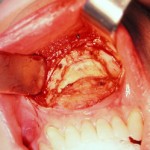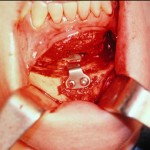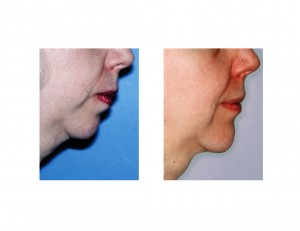Background: Like all surgical implants used in the body, chin implants do have some long-term effects. This is particularly true when they are used improperly or are inadequately positioned. Long-term effects could be underlying bone resorption and loss of horizontal projection. This is most commonly seen with the chin implant is positioned too high and rests in thinner alveolar bone closer to or over the tooth roots.
Case Study: This is a 50 year-old female with the desire to improve her chin position. She had suffered with a short chin her entire life. But she had a history of having had a rhinoplasty and a chin implant in another country when she was 21 years of age. Despite this early surgery providing some improvement, she was still never really satisfied.

Her surgical options were to remove and replace her old implant with either a new larger one in a better position or to move the chin forward (advancement osteotomy) after implant removal. While either approach is a better option than what she had, the amount of chin advancement that she needed made a bone-based operation the best choice. (it could move the chin the furthest forward without using a lot of foreign-material to do it)



Case Highlights:
1) In cases of severe chin shortness, a large implant over time will eventually settle some amount into the underlying bone.
2) Chin implants placed through the mouth can move upward from their desired position on the pogonion. This can be avoided by screwing them into position.
3) When the chin deficiency is large (> 10mms), it may be better to consider a chin osteotomy long-term rather than an implant in some cases.
Dr. Barry Eppley
Indianapolis, Indiana


